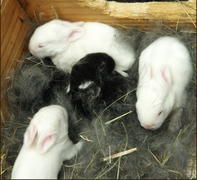Basic Rules for Rabbit Breeding
Always breed with the best quality stock you can afford. There are specialised breeds created for specific products or purposes. The closer you stock is to the breed standards for that breed, the better chance you will have to produce a top quality product.

Always buy your startup stock from a reliable breeder who can give you information about the breed you are buying.
This includes the birth dates and parent lines of each animal. Do not crossbreed. Uniformity of product is what helps achieve breeding goals and crossbred animals cannot do that. The breeder has no idea as to what might pop out.
If crossing is done to provide hybrid vigour in a single generation, this generation must be regarded as ‘terminal’ and not used for future breeding. Only when an experienced breeder chooses to cross-breed (to produce a new colour, or satinise a breed for the first time) and knows to cull anything from these breeding experiments, is cross-breeding acceptable.
Both the bucks (males) and does (females) must be in prime health when the mating occurs. An animal down in condition or in a full moult should not be bred until it has recovered completely. Both bucks and does must be of minimum age, or weight, for the breed.
The minimum age for miniature breeds is 5 - 6 months for bucks and does. For the medium-sized or giant breeds, bucks should be a minimum of 6 - 8 months of age. When breeding the very large breeds keep a check on the does weight. She can be bred and should be, as soon as she reaches adult weight. (Know the breed standard of your chosen breed).
Large breed does can give problems with conception if they are left to long and get too fat. Never breed with an aggressive animal. This bad trait can be carried to the following generations and rabbits are capable of biting or scratching very badly. Aggressive females seldom make good mothers.
By Karoline Steenekamp